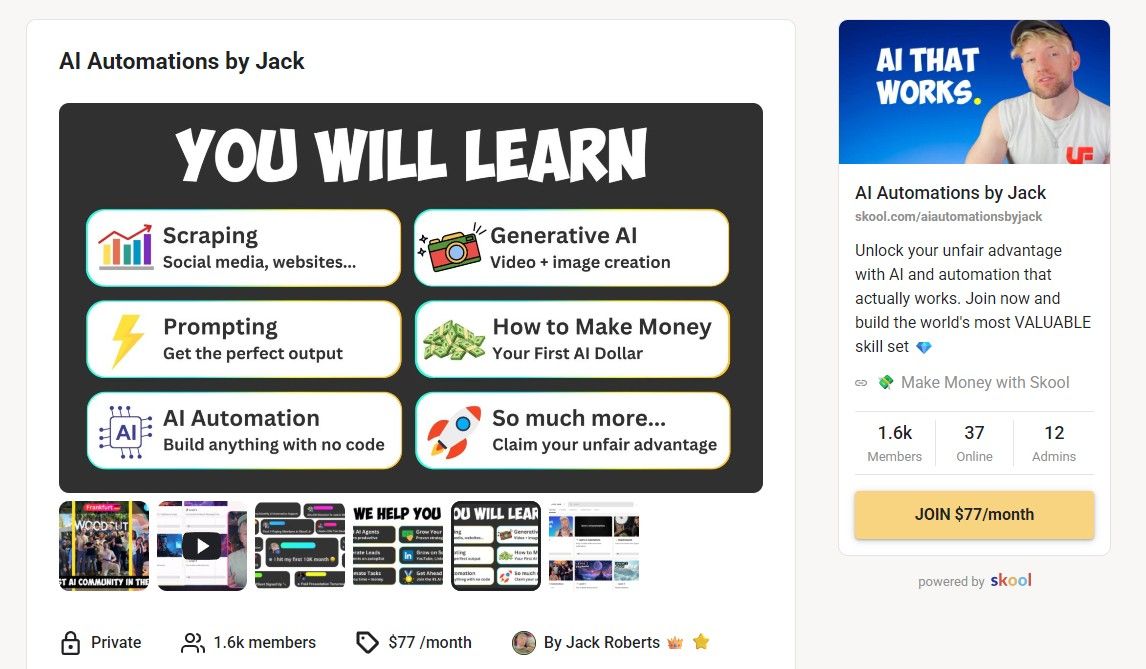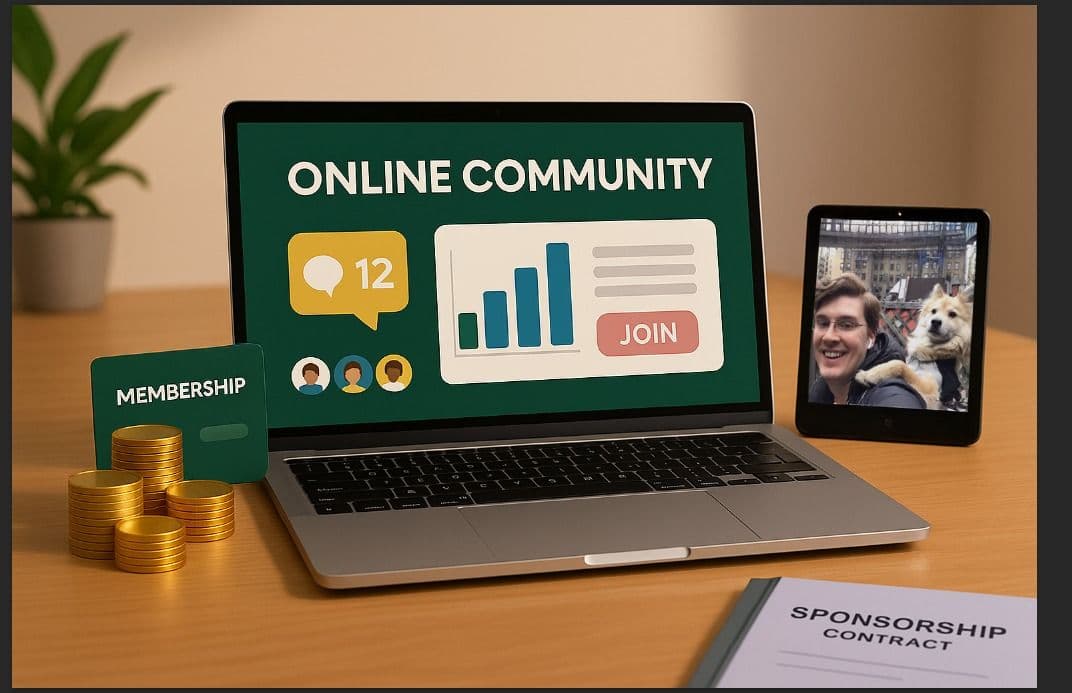After studying community builders for the past decade, I’ve come to recognize a few key strengths that allow communities to not only grow, but ethically monetize into profitable businesses.
Here are 5 playbooks I’ve noticed among many of the top performing community builders:
- Personalized Onboarding: Tailor the experience to make new members feel welcome and engaged from day one. Slack’s approach of recommending relevant channels is a great example.
- Smart Partnerships: Collaborate with like-minded organizations to expand reach. Partnerships like ATÖLYE and EKA Creative Community show how teamwork drives results.
- Member-Driven Content: Encourage members to share their stories and expertise. Dog Spotted’s use of team captains for events boosted engagement and content creation.
- Data Insights: Use metrics like participation rates and churn to refine strategies. Tracking these numbers helps spot trends and improve retention.
- Tiered Memberships: Offer different levels of access (free, premium, enterprise) to cater to diverse needs and grow revenue. Slack’s free-to-paid model generated 43% of their revenue.
These strategies focus on creating value, fostering engagement, and driving sustainable growth.
Y’all ready to build a thriving community? Let’s dive in!
B2B Community Growth Strategies
(focus on where they’re at)
1. Member Onboarding That Works
First impressions matter - especially when it comes to building a thriving community. A well-thought-out onboarding process can turn new members from passive joiners into active participants.
Research shows that 86% of people are more likely to stay loyal to organizations that make an effort to welcome and educate them after they join. This approach isn't just a nice touch my friends, it's a key part of fostering long-term community growth.
Customizing the New Member Experience
An effective onboarding process isn't one-size-fits-all. Personalization is what makes it truly impactful. Here’s how to create a tailored experience:
-
Initial Assessment
Start by gathering details about the new member’s interests, goals, and experience level. This allows community managers to craft onboarding pathways that align with what each individual is looking for. On many community platforms you have ways to survey new joiners, use those questions to do a proper assessment on whether or not they’d be good members. -
Step-by-Step Introduction
Instead of overwhelming new members with too much information at once, break the process into smaller, digestible steps. This makes the experience approachable and keeps engagement high. Think about it like a party. Would you want to be bombarded with questions walking in the door? -
Thoughtful Communication
Use a structured communication playbook to guide members through the essentials. This could include reminders to complete their profile, invitations to join welcome threads, and sharing curated resources, community guidelines, or event updates.
This personalized approach not only makes onboarding smoother but also sets the stage for long-term engagement.
Success Story: High-Impact First Week
A great example of this in action is Slack’s community team. They’ve mastered the art of personalized onboarding by tailoring the experience based on user roles.
They recommend channels that match a member’s industry or team size. This helps new members immediately connect with relevant conversations, see the value of the community, and build lasting engagement.
2. Growing Through Smart Partnerships
Partnerships can be a game-changer when it comes to community growth. By teaming up with the right collaborators, you gain access to new audiences, fresh ideas, and valuable resources. The secret? Choosing partners who align with your values and create a win-win for everyone involved.
Finding and Working with Partners
Start by taking a close look at your ecosystem.
Who shares your values?
Who brings something to the table that complements your strengths?
Partnerships have changed my life, and they were a huge part of our success when building monday.com. Here are the key elements to focus on:
- Value Alignment: Work with partners whose mission and goals resonate with yours.
- Complementary Resources: Identify what unique strengths or assets each partner can contribute.
- Clear Expectations: Define roles, responsibilities, and objectives upfront to avoid confusion.
- Regular Communication: Schedule consistent check-ins to track progress and tackle any challenges early.
"Building impactful partnerships begins with a deep understanding of your community landscape... helping to identify who will bring the most value to a partnership and ensuring that you're designing relationships that are both purposeful and aligned." - ATÖLYE Insights
When these principles are applied, they can lead to tangible results, as seen in the success stories below.
Success Story: Partnership Results
The collaboration between the EKA Creative Community and ATÖLYE is a great example of how partnerships can fuel growth. Here's what they accomplished together:
| Achievement | Results |
|---|---|
| Co-created Events | Hosted more than 15 successful events |
| Talent Pipeline | Brought 6+ creative professionals to ATÖLYE |
| Cross-referrals | Facilitated 10+ member referrals |
| Special Projects | Co-hosted Design Kids Tuesdays Istanbul |
| Industry Impact | Partnered at Impact Fest 2023 |
Another standout example is the Unfold Event Series, where each partner played to their strengths for maximum impact. ATÖLYE Architecture took charge of content curation and visuals, while their community team managed operations and relationships.
Meanwhile, media partner XXI handled communications and outreach. This collaborative approach resulted in over 10 successful event editions, drawing thousands of participants.
"Community-Powered Transformation aims to establish systems that mobilize many-to-many interactions. …Community members who mobilize themselves without a central node take action, bring more people in, grow the community's sense of purpose, and strengthen and sustain the transformation." - Life After Design Thinking
The key to these partnerships' success was creating frameworks that allowed for both independence and cohesion. Each partner had the freedom to launch new initiatives while staying aligned with shared goals.
These stories highlight how strategic partnerships not only increase numbers but also deepen engagement within the community.
3. Member-Created Content That Drives Growth
When members contribute their own content, it can fuel community growth in a way that feels genuine and engaging. By sharing their experiences and expertise, members not only strengthen connections within the group but also attract new, like-minded individuals.
Encouraging Members to Share Their Stories
Getting members to actively participate in content creation requires a thoughtful approach. Two key strategies - recognition and accessibility - can make all the difference.
-
Recognize Contributions: Acknowledge members for their efforts, whether it's sharing expertise, providing feedback, or helping others solve problems. Recognition can be public shoutouts, special badges, or even private thank-yous for behind-the-scenes contributions.
- One of my favorite Skool communities (AI Automations by Jack) does this by using the Skool leveling system, and when members hit a certain level they get custom profile pictures!

- Offer Diverse Content Channels: Not everyone is comfortable writing long posts or creating videos. Provide options that cater to different comfort levels, from short comments to more in-depth articles or event-based contributions.
Success Story: Member Content in Action
The community-building strategy of Dog Spotted highlights just how impactful member-driven content can be. By empowering members to take active roles, they created a vibrant and engaged community.
"Many people are afraid to partner with similar businesses because they think they're a competitor, but I truly believe collaborations can only be a net positive." - Jamie Ruden, Founder of Dog Spotted
Here’s what worked for them:
- Expert Collaborations: Dog Spotted teamed up with dog experts and influencers to produce high-quality content. This not only established trust but also inspired members to contribute their own stories and insights, following the example set by these experts.
- Leadership Opportunities: For their community walkathon fundraiser, they introduced a "team captain" system. Captains took charge of promoting events, recruiting participants, leading walks, and creating content around their experiences. This approach didn’t just generate a wealth of content - it also amplified engagement, as captains brought their networks and unique perspectives into the mix.
"Competitors may come in and steal our ideas, but they can never take away the people who trust our brand because of the support we've provided and the connections we've built." - Jamie Ruden, Founder of Dog Spotted
sbb-itb-bc79881
4. Using Numbers to Boost Participation
When it comes to scaling community engagement, numbers can be a game-changer. By leveraging data, you can spot trends and address issues before members start to check out. This approach works hand-in-hand with earlier strategies, using precise metrics to fine-tune how you interact with your community.
Monitor Member Engagement
Keeping an eye on engagement metrics is crucial for understanding how members behave. As Community-Led Alliance puts it, "Metrics give community managers the data-driven insights they need to understand their audience's behavior, measure the impact of engagement strategies, and identify areas of improvement".
Here are some key metrics to keep on your radar:
| Metric | What It Measures | Why It Matters |
|---|---|---|
| Active Participation Rate | Percentage of members engaging within a specific timeframe | Reflects the overall health of the community |
| Response Rate | Speed and frequency of replies to posts | Highlights the quality of interactions |
| Member Lifetime Value | Total value a member contributes over time | Helps prioritize retention efforts |
| Churn Rate | Percentage of members who leave | Indicates potential satisfaction issues |
Success Story: Data-Driven Member Retention
Real-world examples show how data can transform community engagement. Take FeverBee's case study, for instance. By adopting a metrics-driven strategy, they saved 60% of their team's time, improved response quality, and increased engagement by focusing on underperforming areas.
Their approach involved breaking the community into segments and tracking:
- Average time to first response
- Response rate percentages
- Helpfulness scores
- Active thread counts
This analysis led to targeted improvements, such as assigning virtual agents to struggling areas and featuring unanswered questions on the homepage to encourage quicker responses. As Community-Led Alliance emphasizes, "Community management is critical for fostering a sense of belonging, encouraging active participation, and ensuring a safe and inclusive space for all members".
5. Multiple Membership Levels
Tiered memberships are a proven way to drive growth. Organizations using this approach report a 98% increase in revenue compared to single-price models.
Combining Free and Paid Benefits
The success of tiered memberships lies in offering distinct benefits at each level. Here's a breakdown of how different tiers can deliver value:
| Tier Level | Primary Benefits | Growth Impact |
|---|---|---|
| Free | Basic access, limited features, community discussions | Attracts and engages new members |
| Standard | Enhanced access, learning resources, member directory | Provides a steady revenue stream |
| Premium | Exclusive content, 1:1 mentoring, special events | Increases member lifetime value |
| Mastermind | Custom solutions, dedicated support, bulk licenses | Maximizes revenue potential |
"By creating multiple revenue streams, we've made it easier to focus on supporting our community in exactly the ways they need so they're excited to keep supporting us back." – Allison Esposito Medina
This perspective highlights how tiered memberships can generate diversified income. SaaS companies leveraging tiered pricing also benefit from lower churn rates - 5% compared to 8% for flat-rate models.
Success Story: Profitable Membership Tiers
Real-world examples bring the numbers to life. Take Slack, for instance. In 2020, 43% of their $630 million annual recurring revenue came from users who initially joined via the free plan and later upgraded to paid tiers. This illustrates the potential of a well-structured tiered system to nurture and convert members over time.
To maximize the impact of membership tiers, consider these steps:
- Understand your market: Survey members to gauge their needs and willingness to pay.
- Define tier value clearly: Ensure each level offers distinct and compelling benefits.
- Monitor performance: Track conversion rates, upgrades, and satisfaction levels.
- Refine pricing: Use feedback and usage data to make adjustments.
Structured membership tiers, much like data-driven engagement strategies, deliver measurable results. HubSpot's three-tier model (Starter, Professional, Enterprise) is a case in point. Between 2017 and 2020, this approach helped them grow revenue by 135%, from $375.6 million to $883.9 million.
"Great organizations demand a high level of commitment from the people involved." – Bill Gates
This quote emphasizes the importance of aligning membership levels with varying degrees of member commitment. The ultimate goal? Create clear pathways for members to deepen their engagement and investment as they experience greater value from your offerings.
Steps You Can Take Today
Scaling your community starts with actionable strategies like targeted onboarding, meaningful partnerships, and empowering members to drive content. These steps can help you create a thriving, engaged community.
Adopt a product mindset for your community. Build clear roadmaps, conduct interviews with members, and track essential metrics. Matthew Carnevale, Head of Community at ExitFive, explains it well: "It's so hard to re-engage people if their first week or month isn't good. So you want to get engagement right." Use this approach to fine-tune every interaction within your community.
Here’s a practical framework to guide your efforts:
| Pillar | Actions | Impact |
|---|---|---|
| Member Experience | Personalized onboarding, clear guidelines | Higher retention |
| Content Strategy | Member-driven content creation | Increased participation |
| Measurement | Track key metrics daily | Smarter decisions |
| Value Creation | Tiered memberships, strategic partnerships | Revenue growth |
Incorporating these pillars into your daily operations ensures steady progress toward your goals.
Stay focused and avoid burnout. Arina Kharlamova offers a candid reminder: "The harsh truth is doing more for the sake of more is a path straight to burnout."
Keep in mind that community-led growth often takes 6–12 months to show measurable results. To get started, focus on these key steps:
- Develop clear processes: Include personalized onboarding and set measurable milestones.
- Celebrate member achievements: Share wins, create referral programs, and spotlight accomplishments.
- Leverage automation: Simplify routine tasks while maintaining personal connections.
"Community-led growth is an incredible framework to apply to creator and brand communities–because it flips the 'buying cycle' upside down."
FAQs
How does personalized onboarding improve member engagement and retention in a community?
Personalized onboarding has the potential to boost member engagement and retention by shaping the experience to fit individual preferences and goals. By offering tailored content, resources, or guidance during those crucial first interactions, new members can quickly grasp the value your community offers and feel a deeper sense of belonging.
This tailored approach not only helps members achieve their goals more efficiently but also makes them more likely to stay involved over time. When people feel supported and experience immediate value, they’re naturally more inclined to participate and contribute actively. This creates a ripple effect, fostering long-term growth and loyalty within the community.
What should I focus on when building partnerships to grow my community?
To grow your community through partnerships, concentrate on a few essential strategies:
- Define your goals with precision: Be clear about what you aim to accomplish. Are you looking to boost engagement, reach a broader audience, or provide extra value to your members? Knowing your objectives will guide your efforts.
- Understand your audience: Seek out partners whose values and interests align with those of your community. This ensures their contributions will genuinely resonate with your members.
- Encourage collaboration: Focus on building partnerships with individuals or organizations that bring complementary strengths and resources to enhance your community.
Beyond these steps, work on cultivating an inviting culture that motivates participation. Leverage data insights to fine-tune your strategies over time. Strong, well-matched partnerships can elevate your efforts and help your community flourish.
How do tiered membership models help grow community engagement and revenue?
Tiered membership models are an effective way to boost community participation while driving revenue growth. By providing several membership levels, you cater to a wide range of people - from those who want basic access to those who are willing to pay for premium, exclusive perks. This variety lets members pick a plan that fits their preferences and budget.
On top of that, tiered models bring a sense of progress and inclusion to your community. Members might feel inspired to move up to higher tiers as they see the added value, strengthening their emotional connection and loyalty. This tailored approach not only enhances member satisfaction but also builds long-term support and steady revenue.


